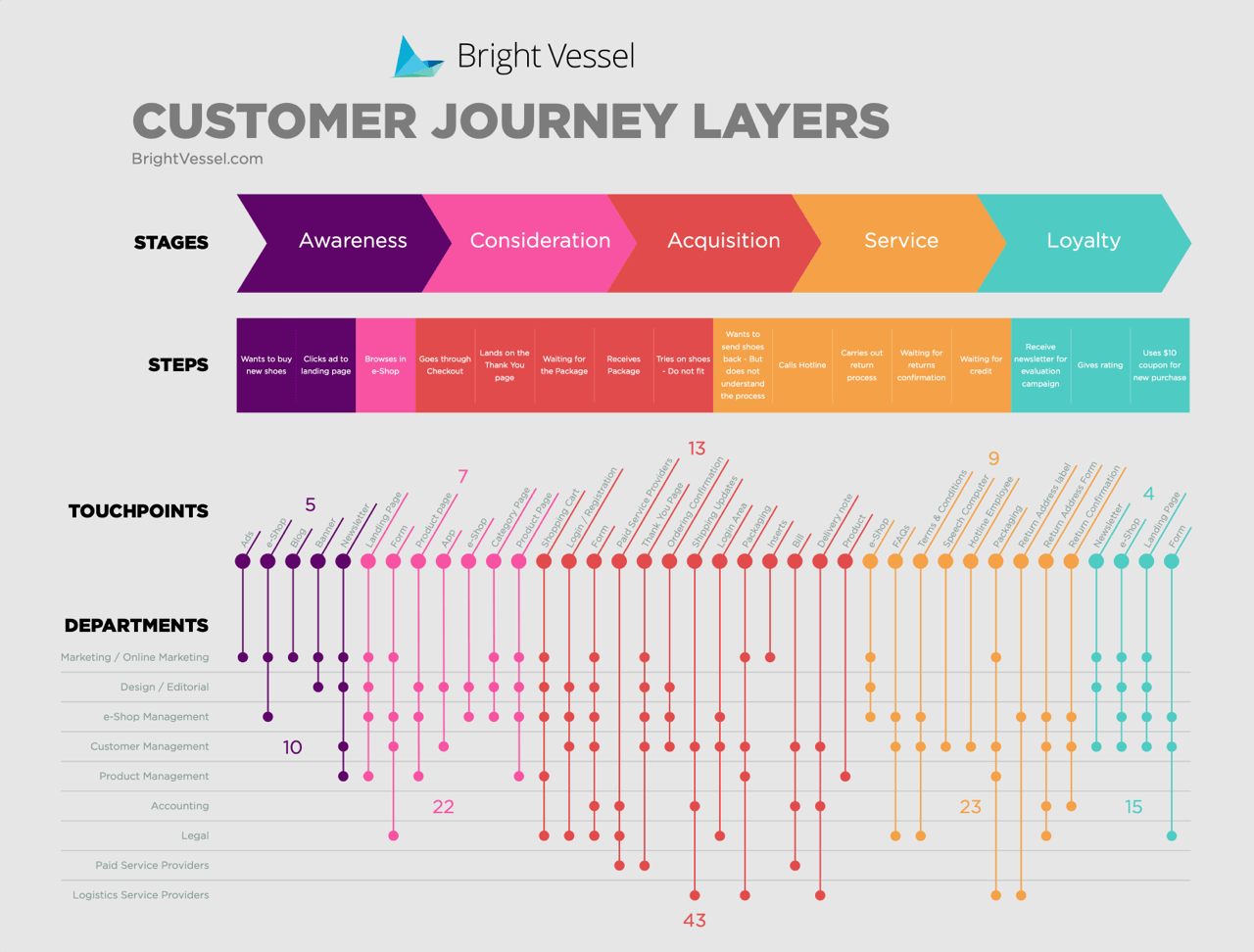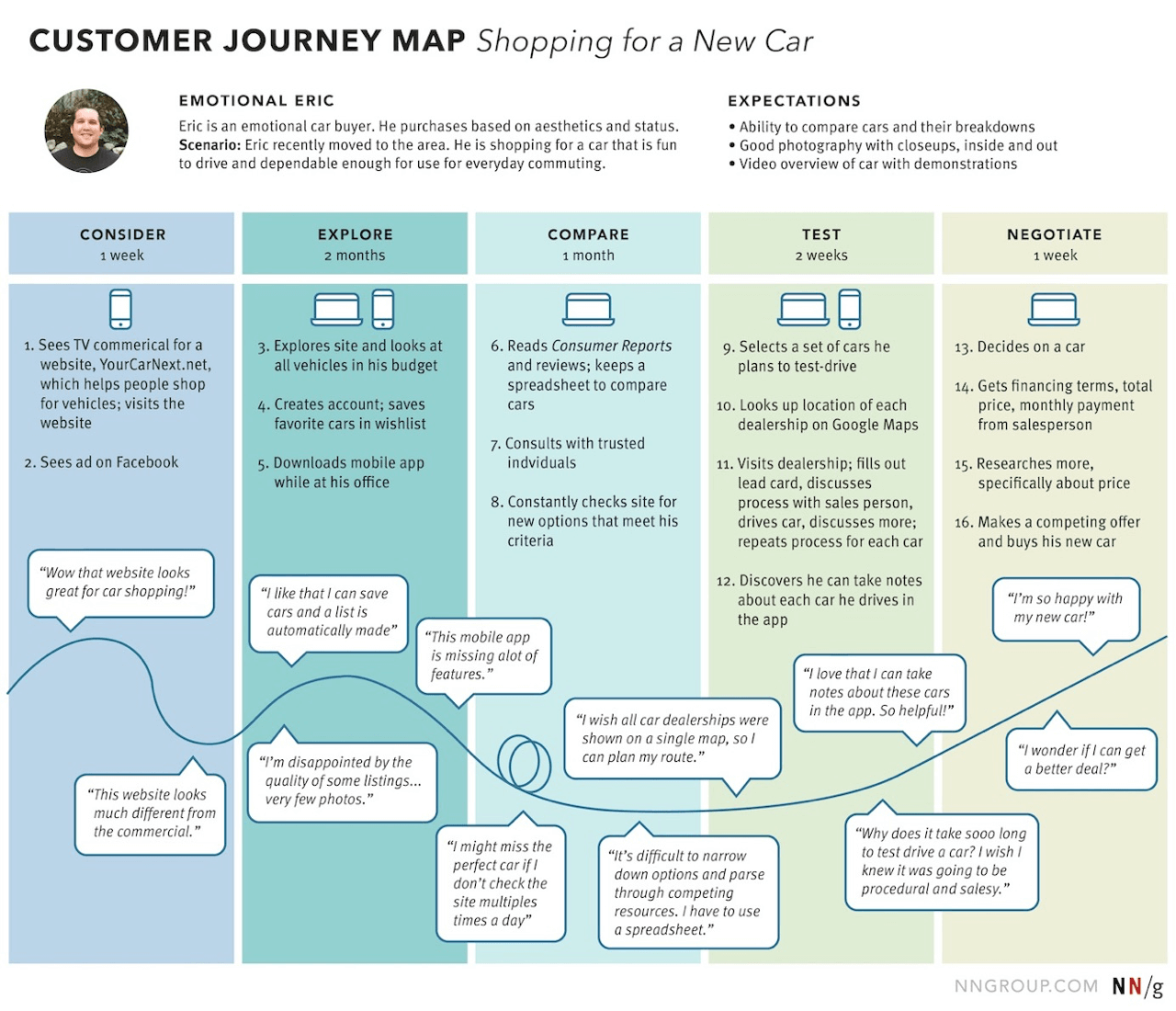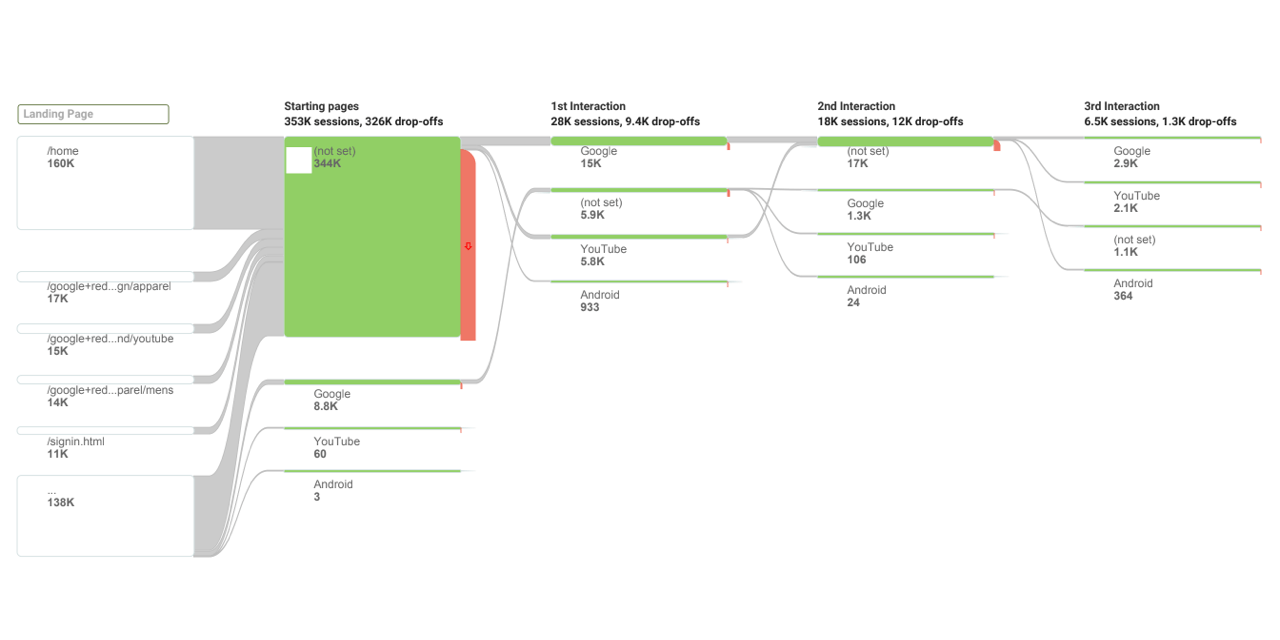How to create an ecommerce content marketing strategy →
How to Define an Ecommerce Customer Journey for Your Store

Have you ever heard a two-year-old kid ask his mother, “where do customers come from?” Probably not, but isn’t it a great question to ask yourself?
Every customer goes through a process, from the moment they first find out about your store to the moment they purchase, regardless of the channel they come from, or the tactic used to attract them.
Understanding where your customers come from, how they become customers, and what you can do to help them go through that process is one of the keys to running a successful ecommerce store.
That’s what an ecommerce customer journey is for. If you want to learn more about it and how you can use it to create a persuasive customer experience, this article is for you.
Let's get started, shall we?
What’s an ecommerce customer journey?
An ecommerce customer journey is the process every customer goes through from the moment they discover your store until they complete a purchase and beyond.
Online retailers use a customer journey as a map that indicates what happens at every stage of the purchasing process: the pages they see, the doubts they have, the time it takes them to buy, and more.
Here is a version of a customer journey map by Bright Vessel, a digital marketing company:
At its core, a customer journey answers a simple question: what do our customers do before they buy from us? This is a powerful question that opens a pandora's box of opportunities to learn about your customers, such as:
- Where do they go searching for information about their problems?
- Who do they trust?
- What do they look for when buying a product?
An ecommerce customer journey is neither a funnel nor a more complicated way to develop a customer persona. Both a funnel and personas fuel a customer journey map: the former with the strategy and tactics you want to use to attract and convert customers, and the latter with information about who they are.
Although they can be incredibly complex and detailed, for a small to medium-sized ecommerce store owner or manager, it doesn’t have to be. At the minimum, you want to use a customer journey to learn about:
- The channels your customers use to find your store
- The ways they evaluate your products
- The fears, doubts, and anxieties they feel before buying
Why you want to map a customer journey
To give shape to a customer journey, marketers create workflows (or “maps”) that show how a customer interacts with your company (the “touchpoints”) and how each one satisfies their needs.
Think of a customer journey as a marketing strategy from the customer’s point of view. With one, you can craft a more effective marketing strategy or refine an existing one to make it more satisfying and effective.
Let’s say your store uses Facebook Ads to bring 90% of your new customers. You’re happy with the results and costs so far. From your view, your touchpoint map looks like this:
- A customer sees a Facebook ad
- They visit a product page
- They add a product to the cart and go to the checkout page
- They purchase and see the ‘Thank you’ page
This process may look great on the outside, but on a deeper look, you may find that your customers check product reviews to see how others value your products before checking out. In fact, product reviews make or break most of your sales.
Here is an example of a customer journey map by the Nielsen Norman Group, a UX research and consulting firm:
If your company doesn’t have too many customer reviews on third-party sites, the anxiety created in this step can reduce your conversion rate without you even noticing it.
As you can see, considering the shopping experience from the customer's point of view allows you to find unique opportunities to improve your marketing strategy.
In the previous example, you may fix the lack of product reviews by sending your products to five top influencers in your industry. Less customer anxiety will lead to higher conversions, lower acquisition costs, and higher profit margins.
An ecommerce customer journey may look overwhelming or even too complex for an overworked ecommerce store owner or manager. However, as you may already know, the better you understand your customers, and the better you serve them, the more success you can expect to achieve.
As explained in a McKinsey article, “those that provide the customer with the best experience from start to finish along the journey can expect to enhance customer satisfaction, improve sales and retention, reduce end-to-end service cost, and strengthen employee satisfaction.”
Developing your ecommerce journey map
Let's start by acknowledging that there’s no one-size-fits-all customer journey. Most customer journey maps have four to five different “stages,” which analyze the different touchpoints customers go through throughout their buying process:
If you find another customer journey map online that best suits you, by all means, use it. But for simplicity's sake, we’ll use the previous five-step process in this article. Here's how you use it:
Step #1: Define your touchpoint
Start by defining every touchpoint that a customer goes through. Here's a short list of some potential touchpoints your customers may experience with your store:
- Awareness
Blog posts, Facebook ads, Google ads, landing pages, home page - Evaluation
Product pages, category pages, newsletter, product reviews, promotional email campaigns - Decision
Checkout page, shipping page, ‘thank you’ page, return policy - Delivery
Support forms, FAQs, product packaging, SMS messages, post-purchase email campaigns - Loyalty
Referral program, loyalty program, post-purchase email campaigns
Don’t list every product page or ad you use. It's better to abstract each touchpoint to get a broad view of your customer’s journey before you get bogged down in the details.
Categorize each touchpoint as you saw above. Once you start finding gaps, you can dig deeper into one specific part of your customer's journey.
For example, you may discover that most of your blog posts bring no conversions. A closer inspection may reveal that a few outliers do because they have mentioned your products contextually. Consequently, you may realize you need to change how you use your blog to communicate about your products.
At the end of the day, keep it simple . Simplify your map if you feel like you're chewing more than you can swallow. It will get more interesting in the next step.
Step #2: Refine your customer personas
Part of what makes a customer journey map so powerful is how it uncovers your buyers’ hidden motivational cues, fears, anxieties, and desires. It mixes your existing marketing research (which I assume you’ve already done) with your marketing strategy, giving it depth.
If you haven't done any customer research, consider that before moving forward, as it’s crucial. It doesn’t have to be extremely detailed. At a minimum, you want to have one customer persona from whom you know:
- What motivates them to buy products like the ones your store sells
- What ultimate goal they want to achieve
- What stops them from buying from your store
- What they like about it
Customer personas aren’t the same as demographic profiles. In general, the age or location of your buyer doesn’t affect the way they shop. Their psychological traits do.
We'll use ecommerce surveys and polls to research your existing customers and visitors (i.e., non-customers) or boost your existing data.
Here's a list of the top four options with some questions to try:
Email surveys
Send them to your past customers to know what they liked about purchasing with your brand, what they didn’t like, and what almost prevented them from buying.Exit pop-up surveys
Ask not more than three questions about what caused them to leave, what they didn’t find, and what your company could do to get them to buy.Slide-in polls
Ask one question to know more about your visitor. You can learn about what’s stopping them from buying, what they’re looking for, and whether they found everything.‘Thank you’ page survey
Ask a few questions about how they found you, their purchase experience, their motivations, and goals with your products.
There’s no need to use complex solutions to start your research. For instance, you can use any free online form builder to survey customers via email, and an app like Getsitecontrol to survey them on your website:
Aim to survey at least 100 people, if possible, more. If you don't have enough traffic yet, you can work with less. However, note that this may not give you representative data.
With the data you gather, create a profile that includes the following information about your buyers:
- Goals
- Motivation
- Fears
- Desires
- Anxieties
Step #3: Analyze your data
This is the tough part where you dig deep into your web analytics to find how each touchpoint performs. You’ll use your Google Analytics data for the most part, but if you use other analytics tools, feel free to use their data.
The first report you want to check out is the Behavior Flow, which will show you how your visitors go through your store. Take particular notes of the pages buyers visit before checking out, as they may help them make up their minds.
The second report to analyze is the Top Conversion Paths , which will show you the channels visitors and customers go through before a conversion. Write down the top converting channels and use the secondary dimension to find more information about their paths.
These reports will help you figure out how your buyers behave before and after buying. This is the brainy part of the more personal analysis done in the previous step.
Above what you have found in the previous step, the data gathered in this one will help you have a customer persona that will include:
- The time it takes them to buy
- The pages they first visit
- The products they visit before buying
- The products they add to cart
- The products they buy
Step #4: Analyze your data to find gaps and opportunities
After you have gathered both qualitative and quantitative data, you will start to see opportunities for improvement. You may find, for example:
- Your ads set false expectations. Those who go all the way up to the point of purchase may not buy due to this initial mistrust your brand earned. The solution will be as simple as rewriting your ad copy and removing the parts where you set up unrealistic promises.
- Your customers have to go around your site looking for the shipping and return policy. By adding these policies to your product pages, you can lower their fears and increase your conversions.
- Your customers feel anxious while waiting for your products, making them less likely to buy in the future. To fix the issue, you could set up a better email campaign that messages customers when the product is fulfilled, with real-time SMS updates.
The gaps and opportunities you’ll find will depend on your research depth and priorities. The more in-depth your research, the better you will understand what your store needs to improve. It's a never-ending process, but it’s one that you must carry regularly.
Create your customer journey map
Customer journey maps are complex beasts, as you can tell. But the consequences of creating one will transform the way you communicate with your customers.
Think of a customer journey map as a customer-focused marketing strategy. Your will tailor your marketing tactics, channels, and messages to the needs and desires of your audience as they progress from discovering your brand until they receive their first order in their homes.
As a TL;DR summary, remember:
- Research your audience using surveys and any other qualitative methods such as interviews, customer support emails, and social media messages
- Check your web analytics data to confirm what you learn from your surveys
- Find what parts of your shopping experience aren’t satisfying your buyers and fix the issues, one touchpoint at a time
Before you know it, your store will sell more, more often, and with happier customers. Wouldn’t you want that for your business? 😉
Ivan Kreimer is a freelance content writer for hire who creates educational content for SaaS businesses like Leadfeeder and Campaign Monitor. In his pastime, he likes to help people become freelance writers. Besides writing for smart people who read sites like Getsitecontrol, Ivan has also written in sites like Entrepreneur, MarketingProfs, TheNextWeb, and many other influential websites.
You're reading Getsitecontrol blog where marketing experts share proven tactics to grow your online business. This article is a part of Ecommerce marketing section.
Subscribe to get updates
Get beginner-friendly tips for growing your online business.





